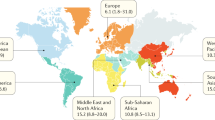Abstract
Background:
What is known of neonatal outcomes associated with maternal obesity is limited. The impact on the preterm neonate, delivery room (DR) course and need for neonatal intensive care unit (NICU) admission has not been well established.
Methods:
A review was done of our 17 county perinatal regions from the New York State Perinatal Data System database over the 3-year period of 1 January 2010–31 December 2012 for mother/baby dyad information for all live births 34–36 6/7 weeks’ gestation. The National Institutes of Health body mass index (BMI) classification was used for maternal BMI with the category definitions of underweight, normal, overweight, obese Level I, obese Level II, and obese Level III.
Results:
Information was obtained on 2155 women. In this group, 29% had obese BMIs. The incidence of pre-pregnancy diabetes mellitus (DM), DM during gestation and cesarean delivery (CD) in obese mothers was significantly different from normal weight mothers, P<0.001. More infants of Level III mothers required DR resuscitation when compared with infants of normal BMI mothers, 36 vs 16%, P <0.001. The need for assisted ventilation beyond 6 h of age and need for NICU admission was more likely in infants of Level III mothers, P<0.001. Women in all of the obese subgroups had preterm infants with increased birth weights (BWs) compared with preterm infants of normal weight mothers, P<0.001.
Discussion:
Late preterm infants born to obese mothers are more likely to be delivered by cesarean section and have larger BWs. We found that infants born to obese Level III mothers are much more likely to require assisted ventilation in the DR and NICU admission.
This is a preview of subscription content, access via your institution
Access options
Subscribe to this journal
Receive 12 print issues and online access
$259.00 per year
only $21.58 per issue
Buy this article
- Purchase on Springer Link
- Instant access to full article PDF
Prices may be subject to local taxes which are calculated during checkout
Similar content being viewed by others
References
Tsoi E, Shaikh H, Robinson S, Teoh TG . Obesity in pregnancy: a major healthcare issue. Postgrad Med J 2010; 86: 617–623.
Leddy MA, Power M, Schulkin J . The impact of obesity on maternal and fetal health. Rev Obstet Gynecol 2008; 1: 170–177.
Rooney B, Schauberger C . Excess pregnancy weight gain and long-term obesity: one decade later. Obstet Gynecol 2002; 100: 245–252.
Chen Z, Du J, Shao L, Zheng L, Wu M, Ai M et al. Prepregnancy body mass index, gestational weight gain, and pregnancy outcomes in China. Int J Gynecol Obstet 2010; 109: 41–44.
Lombardi DG, Barton JR, O'Brien JM, Istwan N, Sibai B . Does an obese pre pregnancy body mass index influence outcome in pregnancies complicated by mild gestational hypertension remote from term? Am J Obstet Gynecol 2005; 192: 1472–1474.
De Paiva LV, Nomura RM, Dias MC, Zugaib M . Maternal obesity in high risk pregnancies and postpartum infectious complications. Rev Assoc Med Bras 2012; 58: 453–458.
Joy S, Istwan N, Rhea D, Desch C, Stanziano G . The impact of maternal obesity on the incidence of adverse pregnancy outcomes in high risk pregnancies. Am J Perinatol 2009; 26: 345–349.
Baeten J, Bukusi E, Lambe M . Pregnancy complications and outcomes among outcomes among overweight and obese nulliparous women. Am J Public Health 2001; 91: 436–440.
Bhattacharya S, Campbell D, Liston W, Bhattacharya S . Effect of Body Mass Index on pregnancy outcomes in nulliparous women delivering singleton babies. BMC Public Health 2007; 7: 168.
Kalk P, Guthmann F, Krause K, Relle K, Godes M, Gossing G et al. Impact of maternal Body Mass Index on neonatal outcome. Eur J Med Res 2009; 14: 216–222.
Heude B, Thiebaugeorges O, Goua V, Forhan A, Kaminski M, Foliguet B et alThe EDEN Mother-Child Cohort Study Group. Pre-pregnancy body mass index and weight gain during pregnancy: relations with gestational diabetes and hypertension, and birth outcomes. Matern Child Heatlh J 2012; 16: 355–363.
Cnattingius S, Villamor E, Johansson S, Edstedt Bonamy A-K, Persson M, Wilstrom A-K et al. Maternal obesity and risk of preterm delivery. JAMA 2013; 309: 2362–2370.
Minsart A-F, Buekens P, De-Spiegelaere M, Englert Y . Neonatal outcomes in obese mothers: a population-based analysis. BMC Pregnancy Childbirth 2013; 13: 36.
American College of Obstetricians and Gynecologists. ACOG Committee opinion no. 549: obesity in pregnancy. Obstet Gynecol 2013; 121: 213–217.
Helslehurst N, Ells L, Simpson H, Batterham A, Wilkinson J, Summerbell CD . Trends in maternal obesity incidence rates, demographic predictors, and health inequalities in 36,821 women over a 15- year period. BJOG 2007; 114: 187–194.
National Heart, Lung, and Blood Institute. Clinical guidelines on the identification, evalutation, and treatment of overweight and obesity in adults. NIH Publication No. 98-4083. Department of Health and Human Services, National Institutes of Health: Bethesda, MD, USA, 1998.
Chu SY, Kim SY, Lau J, Schmid CH, Dietz PM, Callaghan WM et al. Maternal obesity and risk of stillbirth: a meta analysis. Am J Obstet Gynecol 2007; 197: 223–228.
Vinayagam D, Chandraharan E . The adverse impact of maternal obesity on intrapartum and perinatal outcomes. Obstet Gynecol 2012; 2012: 1–5.
Cnattinguis S, Bergstrom R, Lipworth L, Kramer M . Prepregnancy weight and the risk of adverse pregnancy outcomes. N Engl J Med 1998; 338: 147–152.
Meehan S, Beck CR, Mair-Jenkins J, Leonardi-Bee J, Puleston R . Maternal obesity and infant mortality: a meta-analysis. Pediatrics 2014; 133: 869–871.
Author information
Authors and Affiliations
Corresponding author
Ethics declarations
Competing interests
The authors declare no conflict of interest.
Rights and permissions
About this article
Cite this article
Khalak, R., Cummings, J. & Dexter, S. Maternal obesity: significance on the preterm neonate. Int J Obes 39, 1433–1436 (2015). https://doi.org/10.1038/ijo.2015.107
Received:
Revised:
Accepted:
Published:
Issue Date:
DOI: https://doi.org/10.1038/ijo.2015.107
This article is cited by
-
Obstetric and offspring risks of women’s morbid conditions linked to prior anticancer treatments
Reproductive Biology and Endocrinology (2016)



